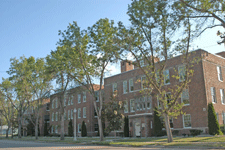Overview
A Premier NIH Facility for Biomedical Research
 Some 3,000 feet higher above sea level than the National Institutes of Health’s (NIH’s) familiar brick campus in Bethesda, MD, and a five-hour, 2,300-mile plane ride northwest of that point, lies Rocky Mountain Laboratories (RML), NIH's state-of-the-art biomedical research facility in Hamilton, MT, a small but thriving community nestled between the Bitterroot and Sapphire Mountains.
Some 3,000 feet higher above sea level than the National Institutes of Health’s (NIH’s) familiar brick campus in Bethesda, MD, and a five-hour, 2,300-mile plane ride northwest of that point, lies Rocky Mountain Laboratories (RML), NIH's state-of-the-art biomedical research facility in Hamilton, MT, a small but thriving community nestled between the Bitterroot and Sapphire Mountains.
A key component of the National Institute of Allergy and Infectious Diseases (NIAID) Division of Intramural Research (DIR), RML is perhaps best known for its research into vector-borne diseases, such as Rocky Mountain spotted fever, Q fever and Lyme disease – three illnesses caused by microbes whose names pay tribute to the former RML scientists who discovered them.
Since 1928, when the landmark facility was constructed – and two decades before that when its scientists worked out of makeshift cabins and tents – RML has played a key role in our nation's health and well-being by focusing its talent and resources on the infectious disease threats of the day. One hundred years ago, that meant helping overcome the scourge of "black measles," which was striking down settlers in Western Montana's Bitterroot Valley at an alarming rate. Today, it means grappling with the more confounding health issues such as prion diseases and antibiotic-resistant bacteria. Moreover, its proven history in the study of exotic illnesses makes RML eminently positioned to play a central role in conducting research that could help safeguard the public against infectious disease threats, including a possible bioterror attack.
RML is not a clinical facility in which researchers study the effects of experimental drugs, vaccines, and diagnostics on patients and healthy volunteers. Rather, you could say that the basic research conducted at RML makes clinical research possible. By focusing on the molecular traits of a given microbe – namely, what the microbe is composed of and how it behaves in its environment – scientists are able to ascertain the most effective target for fighting that microbe and, from there, develop chemicals that could detect, treat, and generate an immune response against it for further study.
The scientific programs at RML are organized into five separate Laboratories. Each Laboratory has a distinguished scientist as its Laboratory Chief, and a number of individual research groups that study specific infectious agents, like Q fever, Chlamydia, Lyme disease, human immunodeficiency virus (HIV), plague, tularemia, Salmonella, prion diseases, and tick-borne encephalitis viruses. Today, RML encompasses roughly 30 buildings on 33 acres of land, and employs approximately 350 people.
In addition, RML’s new Integrated Research Facility, slated for occupancy in 2008, will be the first NIH facility of its kind to house BSL-2, BSL-3, and BSL-4 laboratory space in one building along with administrative offices and conference rooms. The facility – constructed to the most rigorous of engineering standards – will enable researchers to study priority pathogens in the area of biodefense – labeled as Category A, B, or C agents by the Centers for Disease Control and Prevention (CDC) – in the safest and most secure environment possible.
Other resources on the RML campus include two NIAID core facilities, centrally located facilities that house state-of-the-art technologies for use by NIAID researchers in Hamilton, MT, as well as Bethesda, MD. The Genomics Core Unit provides cutting-edge technology and consultation to researchers in the areas of gene sequencing and gene expression. Researchers receive results rapidly and in an easy-to-understand format that enables them to quickly determine potential vaccine candidates, diagnostics, and the like.
The Microscopy Core Unit offers unparalleled expertise and instrumentation in electron and confocal microscopy. RML’s microscopy staff prepare and analyze samples in a variety of ways, from labeling cellular organelles to highlighting the exquisite surface detail of a microbe to identifying surface antigens on that microbe. In addition, specimens can be observed in real-time by NIAID researchers in Hamilton and Bethesda. Work performed at RML has been featured on the covers of numerous prestigious scientific journals, including Proceedings of the National Academy of Sciences, Virology, and Nature.
That a biomedical research facility the size and technological sophistication of RML is located in the heart of the Bitterroot Valley offers Montanans unique access to the utmost in collaborative, educational, and employment opportunities with world-renowned scientists. And for NIH scientists, RML provides a truly exceptional place to live, study, and conduct pioneering research that could one day lead to a cure for some of the world’s most formidable infectious diseases.
back to top